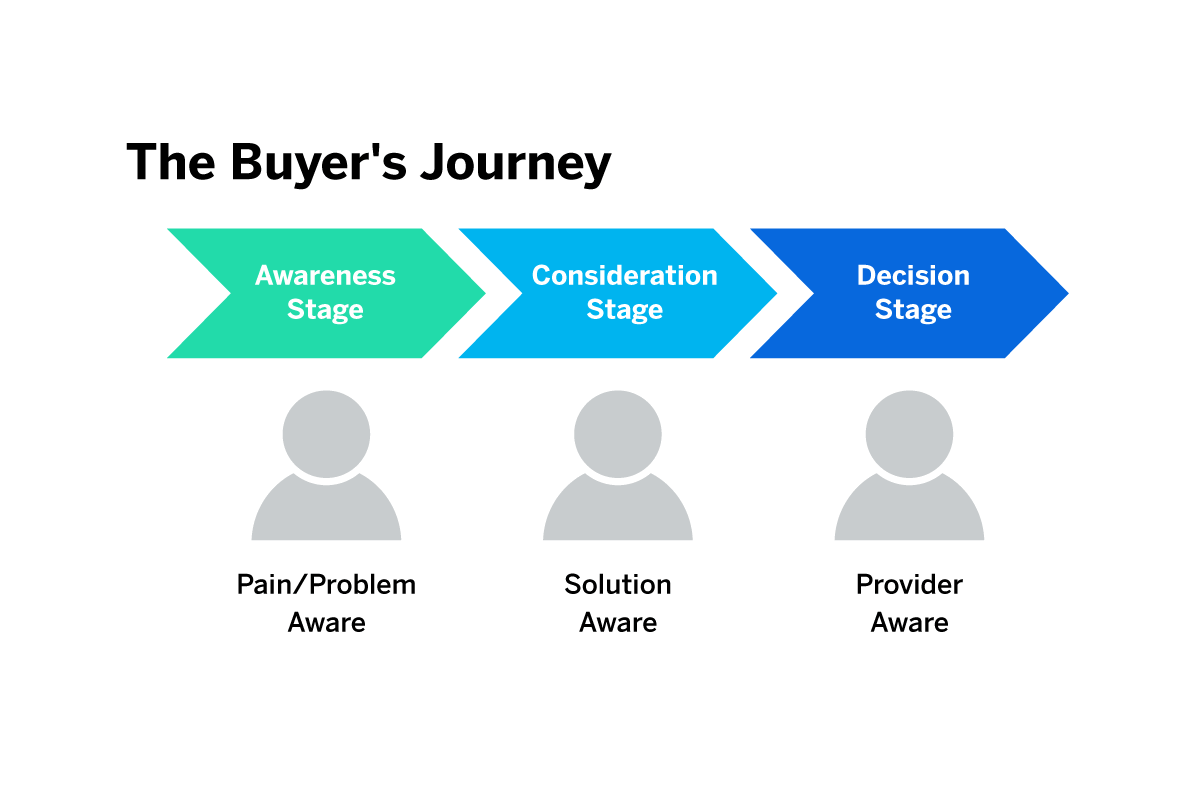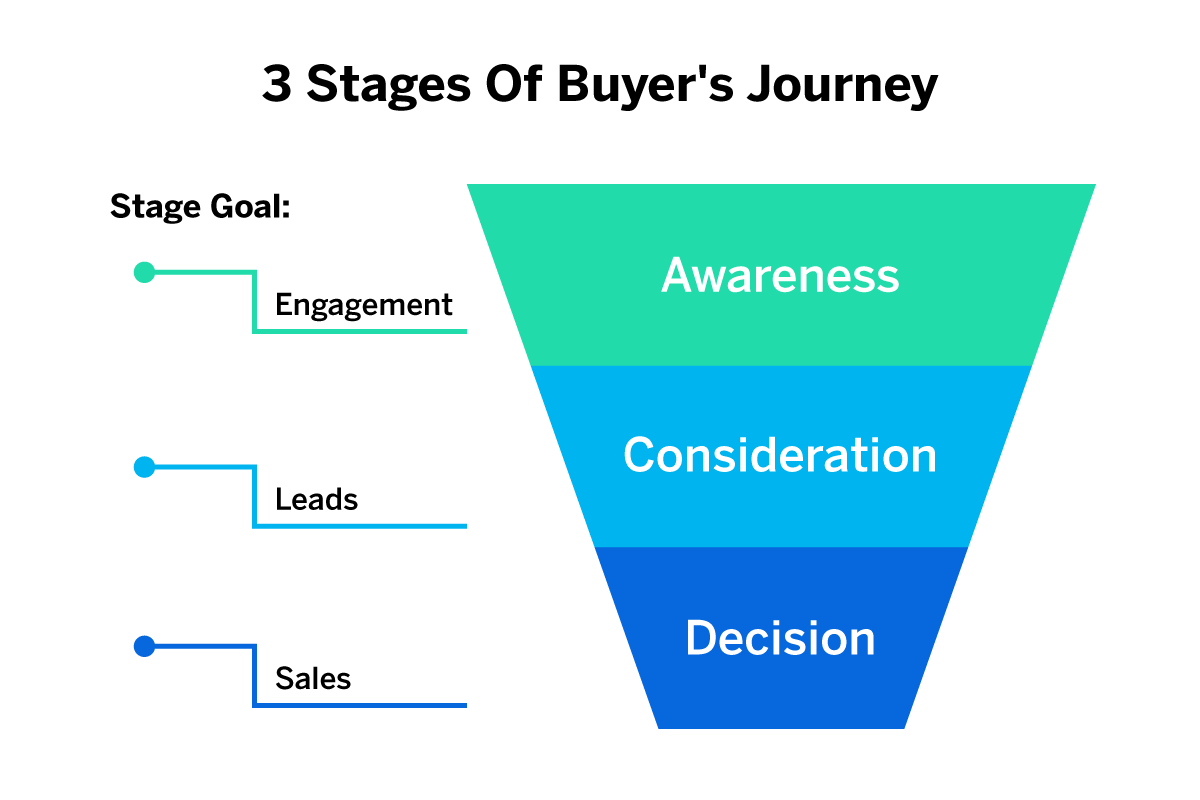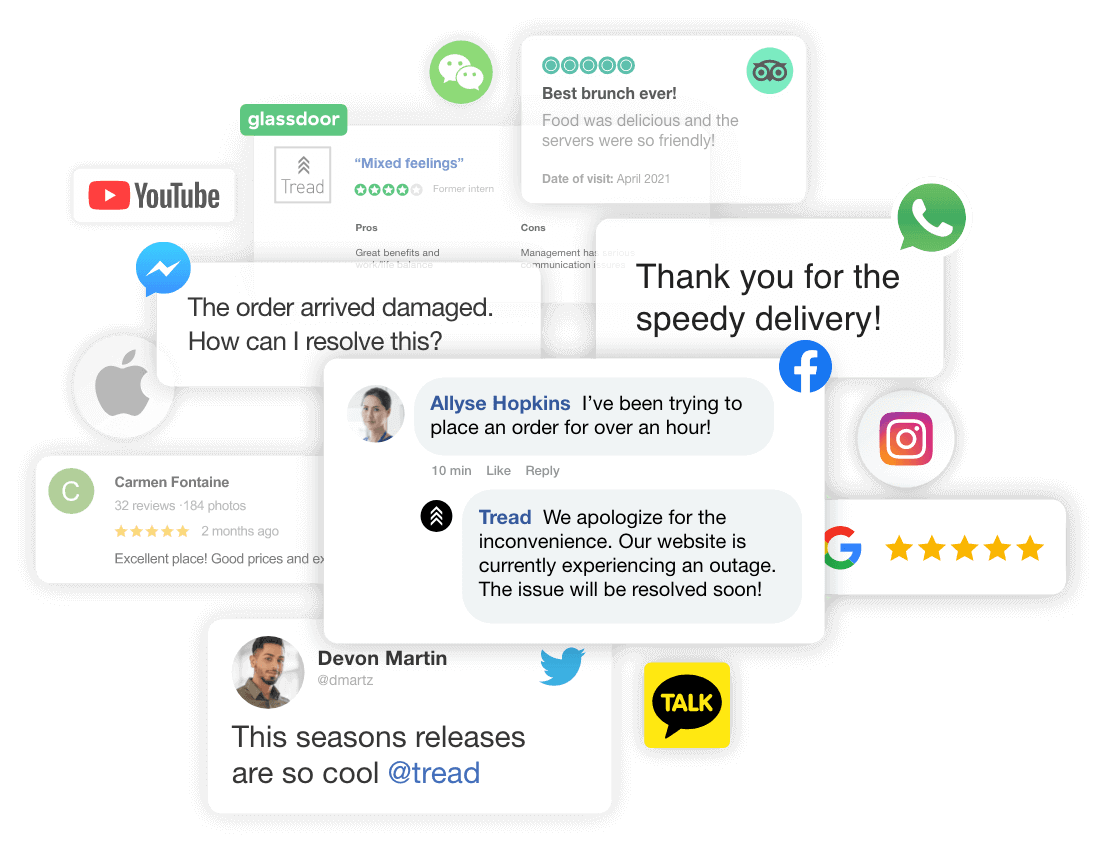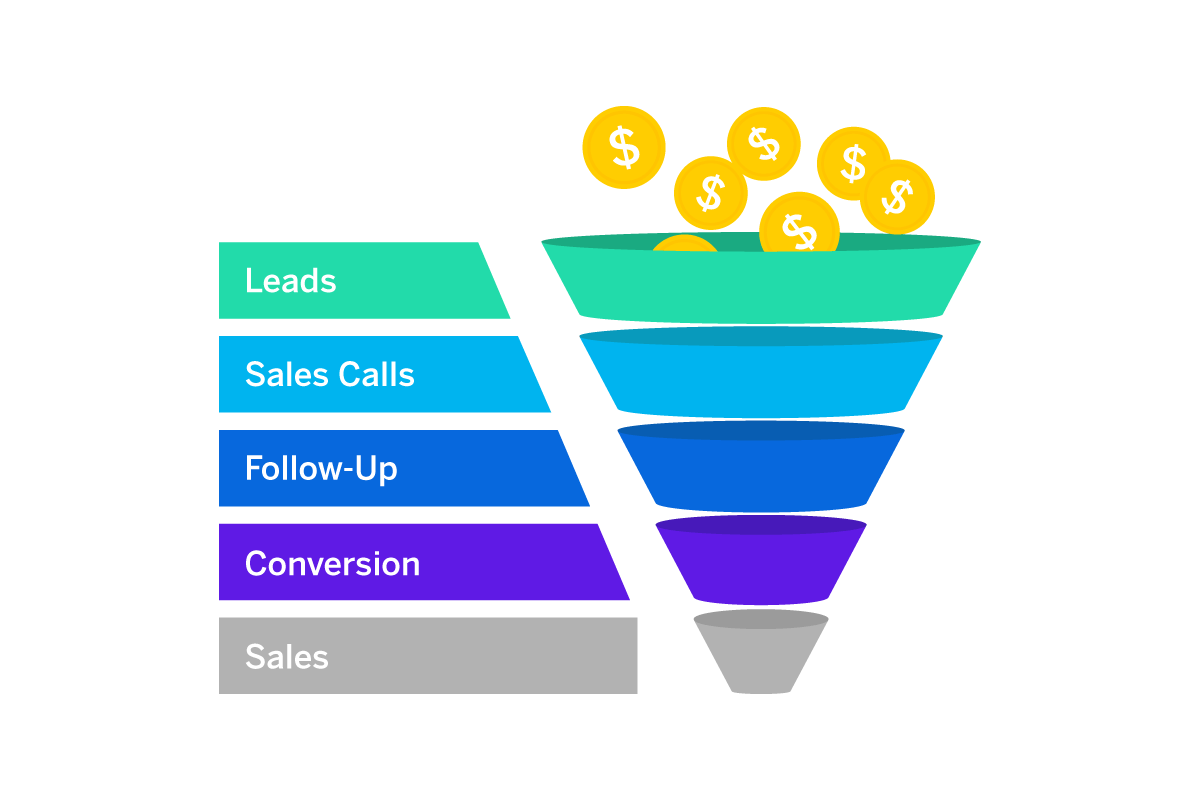What is the buyer’s journey?
Whenever you buy something – whether it’s a big lifestyle purchase like a car, something for your business like a software suite, or even a fast-moving, disposable consumer product like a coffee – you never do so without having gone on what we call the buyer’s journey.

That journey may or may not be a conscious one, but either way, the particular cup of coffee you end up with, from a particular store, is the result of a bunch of external and internal factors all working to move you along a route – a route that ends with your buying decision.
In other words? The various buyer’s journey stages describe the path along which people move towards making a purchase.
Buyer journey vs customer journey
Buyer’s journey and customer journey seem like incredibly similar terms, but there’s a big difference between the two, and they each require distinct focus:
The buyer’s journey describes the steps that lead up to a purchase decision but stops right there.
That means it’s all about persuasion and influence aimed at brand new customers. The customer journey, on the other hand, follows on from this, referring to the steps businesses can take to build relationships with existing customers.
In practice, that means adopting a focus on things like customer support and customer experience, as well as using existing customer data to create content marketing strategies that influence repeat decisions, recommendations, and customer loyalty.
In super simple terms, the buyer’s journey is all about saying “our product is great, you should give it a try,” while the customer journey is more about saying “remember that great experience you had with us? We’ve got more for you!”
Free course: Customer journey management & improvement
Buyer’s journey stages vs the sales funnel
Similarly, the buyer’s journey is a different concept from the sales funnel. That’s because the former is all about a customer’s intent to purchase generally, while the latter relates only to their intent to purchase from you. Because of this, the traditional funnel typically has more steps, since you can track things specific to your organization – like leads and negotiations.
Buyer’s journey stages: How many steps are there?
As with all good journeys, the buyer’s journey has a defined beginning, middle, and end. It’s universally broken out into three stages: the consideration stage, the awareness stage, and the decision stage.
Let’s explore how this works…
How does the buyer’s journey work?
So how do those buyer’s journey stages actually flow? While they’re all slightly different depending on things like industry, target audience, and product type, some commonalities run through every single buying process.
Here’s what every stage of the buyer’s journey looks like:
1. Awareness stage | Buyer’s journey
This is the first stage of the buyer’s journey, and it often gets mixed up. In the sales funnel, awareness refers to a customer becoming aware that your company exists. In the buyer’s journey, however, things are slightly different. Here, the awareness stage really means that they have become aware of a pain point.
In a B2B environment, that might be that they’ve discovered their business is losing precious time and resource on an internal sales process that they think could be streamlined. In a B2C environment, perhaps they realize that their home-office chair makes their back hurt.
At this point, they won’t be exploring clear solutions, but rather they’ll be doing general research or asking around about the issue, intending to understand its scope better.
In the awareness stage, the buyer is aware of a problem:
“I have an issue with [X], I wonder if there’s something I can do about it.”
2. Consideration stage | Buyer’s journey
The consideration stage sees the customer move from basic research toward building a list of possible solutions. So from your point of view as a business, this stage is about showing how you can help resolve consideration stage buyers’ pain points in a way that builds confidence in the quality and competitiveness of your offering.
Using the examples described above, the prospective B2B customer has determined that either a better internal sales process software suite, or a package of training is the answer they need, and will use this stage to compare and contrast different options. The B2C customer has determined that they need either a new office chair or a standing desk solution.
In the consideration stage, the buyer is aware of possible solutions:
“One of these options will fix my problem.”

3. Decision stage | Buyer’s journey
At the decision stage, your potential customers will be making decisions on which products or services will work best for them. So, while the consideration stage was about building out solutions, here they’ve picked a solution and are now narrowing down actual products or services.
Again, with the examples above, the decision stage will see the B2B customer comparing sales process software pricing and reviews, while the B2C customer has a shortlist of new chairs to choose from.
A host of things ultimately affect their final decision, from price, features, and competitiveness, to reviews from others and overall brand reputation.
In the decision stage, the buyer is aware of providers and products:
“I’m either going to purchase [X] or [Y], depending on which one seems better.”
B2B vs B2C buyer journey
It’s worth keeping in mind that the buyer’s journey relies on different factors depending on whether you’re in a B2B or B2C market.
In the B2C market, potential buyers are usually individuals or families, with specific needs particular to themselves. So they might be most concerned with convenience, or their financial ability to buy your products or services.
That means relationships might be formed over a shorter period, resulting in sales and outbound/inbound marketing targeted at a very broad customer base via market segments or through buyer persona work.
In the B2B market, we think of the concept of a customer a little differently. Often there are up to ten stakeholders – from the executive buyer to the end-user – with varying interests, concerns, and goals. A B2B purchase decision is often carefully considered and scrutinized, with long-term use in mind, so relationships are sometimes formed over a longer period.
As such, your relationship will be built with more than just the final decision maker – it’s the connection you foster with all stakeholders that will make or break a sale.
Why should businesses care about the buyer’s journey?
Understanding the buyer’s journey is how you can insert your business and products as the solution to your customer’s needs at every step of the process. It’s an opportunity to be an obvious solution, even when customers aren’t even sure they need one yet.
Seizing those opportunities relies on outbound/inbound marketing efforts that land your messaging in different ways, for different times. If you can track the buyer’s journey against audience personas, you’ll be able to uncover unique needs and meet them with information that isn’t one-size-fits-all.
Some 96% of website traffic occurs during the first couple of phases of the journey before decision-making begins, and in the B2B space especially, people spend up to 90% of the decision journey educating themselves.
So it stands to reason that businesses can massively benefit by broadening their marketing and outreach efforts to include material that caters to people not yet at the decision-making part of the process.
For instance, relevant content marketing can be more powerful than advertising, if it hits at the right part of the journey. 80% of B2B decision-makers, for instance, prefer to get their information from a series of articles than from an advert.
Being able to provide that collateral is what will edge your business out ahead of your competitors.
Buyer Journey optimization
Analyst firm IDC famously once described the buyer’s journey as follows:
“The buyer journey is nothing more than
a series of questions that must be answered.”
And if the buyer is asking questions – consciously or subconsciously – it’s your job as a business to be able to provide answers at every step of the journey. In practice, that means optimizing your marketing and advertising and looking to create content so that everything together can tell a customer, in no uncertain terms, that you’re the best solution.
It might seem initially complicated and time-consuming to split your marketing, advertising, website, social, sales strategy, and content strategy up into three chunks like this, but your potential customers will be interacting with your brand at each stage of the buyer’s journey (whether they realize it or not), and don’t necessarily want to be put off by stumbling onto something that attempts to force them into a sale.
Understanding that it’s a journey – and that you can be there at each step with something useful and relevant – is the key to success. Here’s how:
Buyer’s journey: Optimizing the awareness stage
In the awareness stage, the last thing people want is a pitch from sales reps or advertisement-heavy content. Instead, they need information that answers broader questions around their issue.
If we take the B2C example above of someone suffering from back pain while working from home, they might Google ‘is sitting all day bad for you?’ or something similar. As marketers and business owners, we need to create content that answers that question, without it being overtly advertorial.
In that sense, the awareness stage can be optimized by providing rich, SEO-friendly, relevant content around the broad-strokes topics your category frequently deals in. In this example, that might be a series of articles around the evolution of the home office, a video on best practices when working from home, and/or a webinar on home working ergonomics.
In social, that might also mean performing social listening to find people Tweeting or posting about their issue, and responding with links to helpful information – not necessarily that your business owns. Why? Well, because simply being helped is enough to form a positive association with your brand in their minds.
When it comes to advertising and more traditional marketing here, you’ll want to be very top line. Buyers in the awareness stage are more receptive to brand messaging and brand identity content, than “here’s a product you’ll love” messaging.
Buyer’s journey: Optimizing the consideration stage
During the consideration stage, we need to get personal. That means conducting market research to develop personas and using historical operational data to find out how each buyer persona can best be served.
If, for instance, people are coming to your site with a specific problem during the consideration stage, you can design the information and resources across your site to better funnel them towards a specific solution, without it seeming like a race to the checkout basket. Think about the omnichannel steps each persona uses on their buying journey, and meet them there.
That might mean using paid search ads against specific keyword terms or designing information flows that educate on the way towards decision-making. The balance is in creating educational pages, posts, and resources that fully convey your solution as one of many, without it feeling like a pitch from a sales team.
When it comes to consideration stage content, case studies are a great way to tick that box, as they help put your prospective customer in the shoes of a real person who has had a similar problem to them.
Buyer’s journey: Optimizing the decision stage
In the optimization stage, we can get right to the point. Here, you need to be sure your product or service messaging is crystal clear in terms of benefit, features, and price – especially as to how it compares to your competitors.
This is a great stage to leverage third-party reviews; if you know your company has had praise on sites like TrustPilot, that should be integrated into your website. If you have customers that you know are loyal and satisfied, post testimonials from social media or CSAT or NPS surveys.
This is also where a B2B lead generation strategy comes in. If you provide gated assets or collect information from any other means, formalize a process by which your sales team can contact these leads and offer to show them how your product works and what it can do for them.
You need to be able to create content across every touchpoint – website, social media, in-store, on the phone – that creates a compelling package and leaves potential customers in no doubt that your product will solve all their problems and then some.
Buyer’s journey: Making customers feel understood
Whether you’re looking at the buying journey, the customer journey, or a funnel that generates leads, the most important thing is to ensure that prospective and existing customers feel listened to and understood.

With today’s customers preferring to interact with brands on a multitude of channels, as well as to self-teach and zig-zag around different information sources, the best way to make them feel understood is twofold:
1. Perform a thorough journey mapping audit
2. Implement a comprehensive experience management suite
It’s only when you can listen to everything customers say (online, in-app, or on the phone) alongside data that shows audience and persona behavior that you’ll be able to make meaningful actions that strengthen your brand’s offering.
How to map the B2B buyer journey
Get that right and you’ll be able to retain customers, foster brand loyalty, and decrease churn.
How Qualtrics can help
The Qualtrics Experience Management Platform™ is built to enable that powerful workflow, bringing real-time and historic data together to proactively suggest actions and changes that can help influence purchasing journeys on an individual basis, no matter the stage. Click here to learn more.
Free course: Customer journey management & improvement
